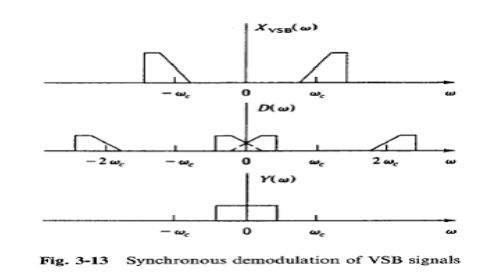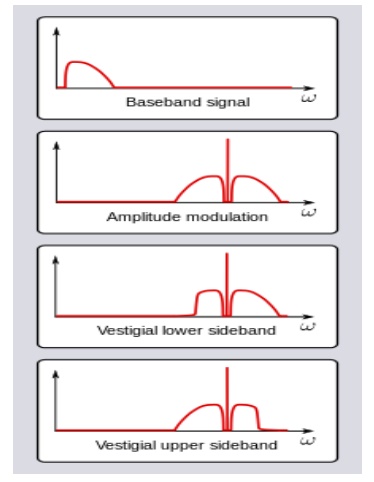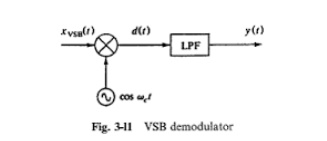Chapter: Communication Theory : Amplitude Modulation
Vestigial Side Band (VSB) Modulation
VESTIGIAL SIDE BAND (VSB)
MODULATION:
• The
following are the drawbacks of SSB signal generation:
1. Generation
of an SSB signal is difficult.
2. Selective
filtering is to be done to get the original signal back.
3. Phase
shifter should be exactly tuned to 90°.
• To
overcome these drawbacks, VSB modulation is used. It can view as a compromise
between SSB and DSB-SC. Figure1.5 shows all the three modulation schemes.

ü Spectrum of VSB Signals:

FIG 1.6
Spectrum of VSB Signals
Ø Vestigial sideband (VSB) transmission is a
compromise between DSB and SSB
·
In VSB modulation, one passband is passed almost
completely whereas only a residual portion of the other sideband is retained in
such a way that the demodulation process can still reproduce the original
signal.
·
VSB signals are easier to generate because some
roll-off in filter edges is allowed. This results in system simplification. And
their bandwidth is only slightly greater than that of SSB signals (-25 %).
·
The filtering operation can be represented by a
filter H(f) that passes some of the lower (or upper) sideband and most of the
upper (or lower) sideband.

·
Heterodyning means the translating or shifting in
frequency.
·
By heterodyning the incoming signal at ωRF with the local oscillator
frequency ωLO, the
message is translated to an intermediate frequency
ωIF, which is equal to either the
sum or the difference of ωRF and
ωIF.
· If ωIF = 0, the bandpass filter
becomes a low-pass filter and the original baseband signal is presented at the
output. This is called homodyning
Ø Heterodyning: Image Response:
Methods
to solve the image response in heterodyne receiver
1. Careful
selection of intermediate frequency ωIF for a given frequency band.
2. Attenuate
the image signal before heterodyning.
Advantages:
• VSB is a form of amplitude modulation intended
to save bandwidth over regular AM. Portions of one of the redundant sidebands
are removed to form a vestigial side band signal.
• The actual information is transmitted in the
sidebands, rather than the carrier; both sidebands carry the same information.
Because LSB and USB are essentially mirror images of each other, one can be
discarded or used for a second channel or for diagnostic purposes.
Disadvantages:
• VSB transmission is similar to (SSB)
transmission, in which one of the sidebands is completely removed. In VSB
transmission, however, the second sideband is not completely removed, but is
filtered to remove all but the desired range of frequencies.
Related Topics